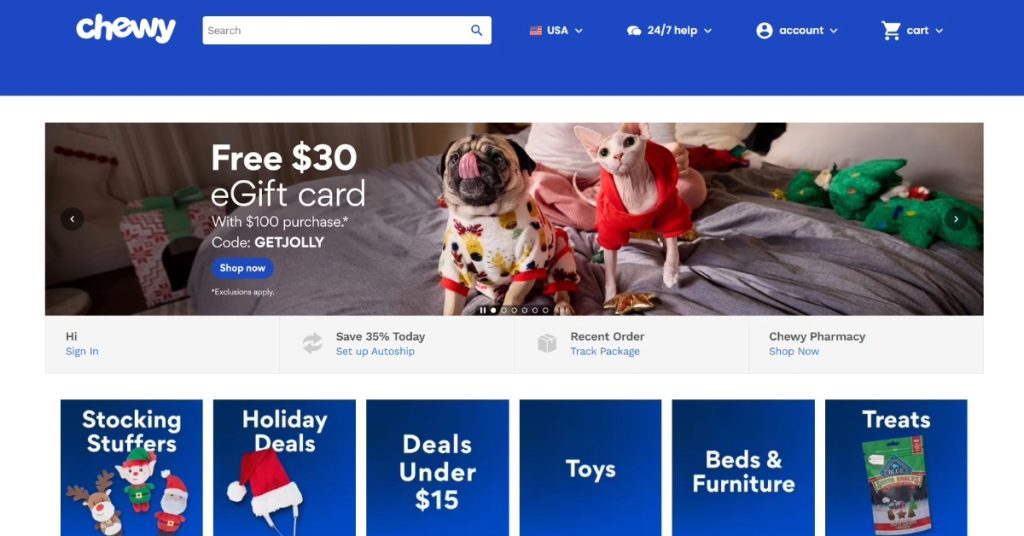
Chewy marketplace case study: book a demo to start yours
Chewy is an e-commerce company focused on pet supplies, offering a diverse selection of pet products such as food, toys, and accessories, serving the needs of pet enthusiasts and those who own animals. If you’d like to start your own marketplace like Chewy, you’re facing a buy vs build decision. So before you decide to build it in-house on top of Spree open-source, consider using the feature-rich Enterprise Edition cutting your time-to-market to a few weeks.
Build vs Buy a marketplace?
The use of open-source brings several advantages, such as total ownership and the ability to adapt as needed, but these benefits have their own costs. Developing a comprehensive marketplace solution is a lengthy, expensive endeavor, usually taking several months to years, as learned from various marketplace projects.
If you haven’t raised a significant amount of money, you’re much better off choosing a complete, off-the-shelf marketplace solution like Vendo, as advised by someone who has extensive experience in billing clients for marketplace development.
Back to the Chewy marketplace case study
Chewy, an online retailer specializing in pet products, has rapidly become a household name since its inception in 2011. Founded by Ryan Cohen and Michael Day, Chewy set out to redefine the pet supply industry with an emphasis on customer service and a vast product range.
The company’s journey began with a challenge; securing funding in a market dominated by heavyweights like Amazon. However, their persistence paid off when they received a $15 million investment from Larry Cheng of Volition Capital, after initially being turned down by over 100 investors.
Chewy’s growth has been nothing short of phenomenal. By focusing on customer-centric services and expanding their product range, they achieved an impressive 300% yearly growth in the early years.
Their commitment to customer satisfaction was evident in their round-the-clock customer service and initiatives like sending out 5 million personalized cards and custom oil paintings of pets to their customers. This approach not only endeared them to pet owners but also built a loyal customer base.
Though initial issues like staffing and technical glitches were hurdles, these were eventually smoothed out, cementing Chewy’s ability to deliver excellent service. By 2016, Chewy reported $901 million in revenue, with plans to add more fulfillment centers.
The company’s success drew attention from major players in the pet retail industry. In 2017, Chewy was acquired by PetSmart for $3.35 billion, marking the largest e-commerce acquisition at the time.
Despite this acquisition, Chewy continued to thrive independently, going public in 2019 with a valuation near $9 billion. As of 2021, Chewy’s stock is valued at over $43 billion, illustrating its immense growth and success in the e-commerce space.
Chewy’s journey from a startup to a leading e-commerce giant demonstrates the power of customer-focused strategies, innovative operational approaches, and adaptability in the face of challenges.
Their story is a testament to how understanding and meeting customer needs, combined with strategic business decisions, can lead to remarkable success in the highly competitive online retail market.
How to emulate Chewy’s marketplace success?
To achieve a level of success similar to Chewy, you should think about launching your marketplace sooner rather than later, ideally in weeks rather than months. Check how well your range of products meets the needs of your audience. Continuously refine your customer acquisition strategies based on real experiences.
Test the waters of the market before you dive into building it yourself.
Here’s how to get started:
- Book a marketplace demo call: We’ll help you evaluate Spree for your marketplace needs and get started with the Enterprise Edition
- Customize your Storefront: Use the drag & drop page builder or custom CSS
- Onboard Brands: Invite your brands or choose brands from our catalog
- Select Products: Curate products and collections manually or automate it
- Embed products: Make your content, newsletters, social media shoppable
- Get Paid: Get paid as soon as products are shipped by the brands
- End-to-end automation: brands sync, fulfillment, payouts, invoicing, taxes
When you’ve tried all that and it works, start thinking about building your own, custom-made marketplace project based on Spree Commerce. First, by decoupling the storefront and going headless with marketplace API, and later with your own backend, if you decide you really need it. Just lift and shift the storefront.
Nobody has to know what’s under the hood, right?



